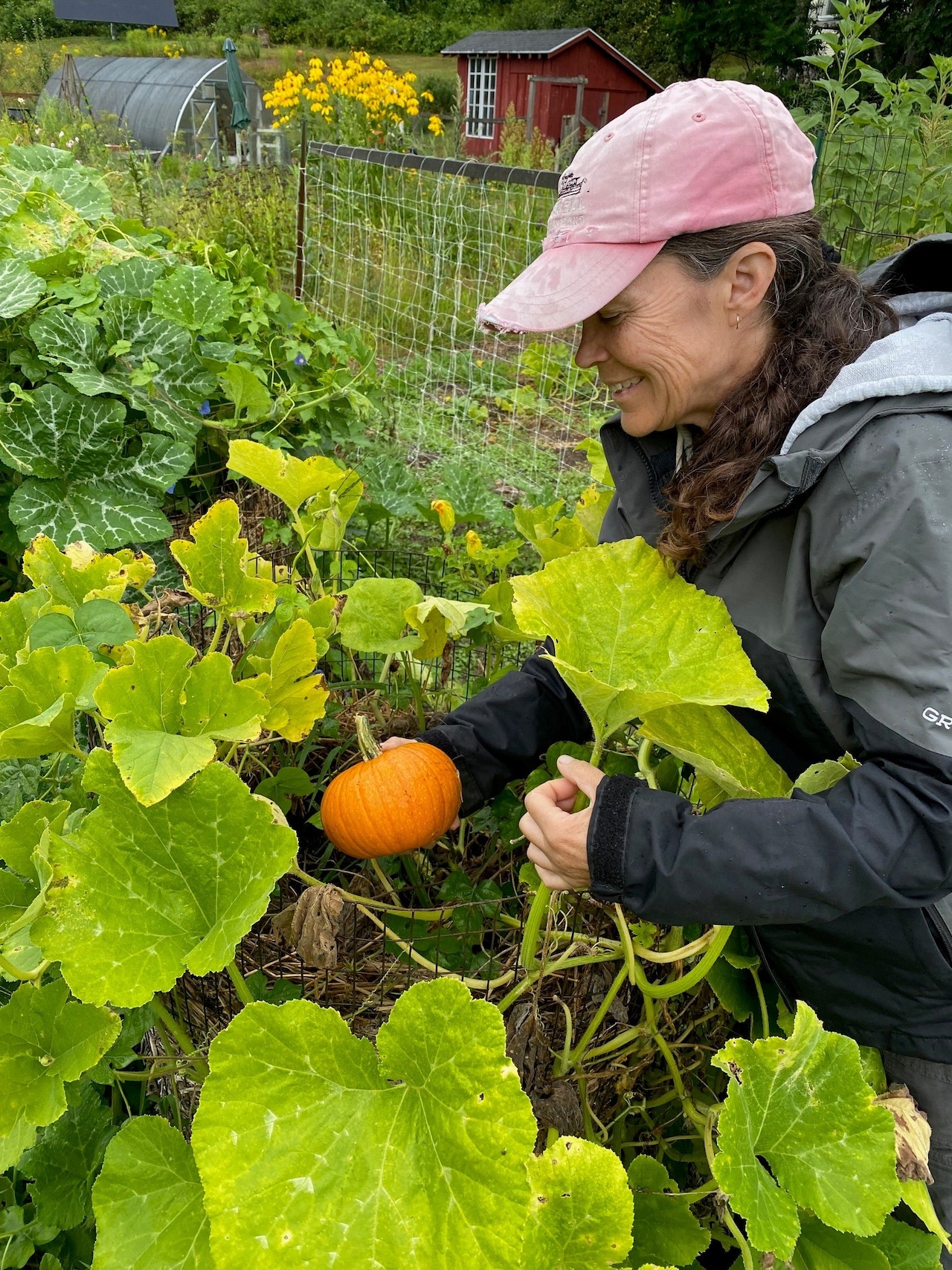
Each month in Garden Talk, you’ll meet a different master gardener or expert plant person from western Massachusetts, learn about their gardening lives, and get advice on everything from pumpkins to houseplants. A big part of gardening is community — people sharing tricks, trowels, plants and a general love of gardening — and these stories are an extension of that ethos.
Mums, kale and so many other wonderful fall classics are flourishing in pots and gardens all over western Massachusetts, but today we’re focusing on perhaps the most popular squash this time of year: pumpkins. Horticulturist and plantswoman Jennifer Kujawski, who earned a bachelor’s degree in botany at the University of Massachusetts and a master’s degree in horticulture at the University of Maryland, will share a slew of tips for growing and harvesting pumpkins.
Kujawski co-authored the “Week-by-Week Vegetable Gardener’s Handbook” with her father, Ron Kujawski. These days, Kujawski works as a private gardener and garden educator. “I actually work alongside several of my clients, teaching them about plants, gardening techniques, and designing or renovating garden plantings with them,” she says.
Q. How did you start gardening?
Kujawski: I grew up gardening — my first real memories are of “working” (playing) in the vegetable garden with my younger brother when I was about 7 or 8. As a teenager, I worked at local nurseries during summer vacations, but I don’t think I considered pursuing a career in working with plants until my junior year at UMass when I realized I already knew quite a bit about plants, liked learning more about them, and enjoyed working with them (and with other “plant people”).
Q: Tell us about the gardening book you wrote with your dad.
Editor’s note: Kujawski’s dad, Ron, is a well-known master gardener and founder of the Western Massachusetts Master Gardener Association as well as a retired UMass Extension educator with onion farming roots.
Kujawski: When the idea of writing “Week-by-Week Vegetable Gardener’s Handbook” was broached by an editor at Storey Publishing, I was coming back to my hometown after working in a larger agronomic context with the US Department of Agriculture in Beltsville, Maryland. It was exciting to work with my dad as co-author and re-learn so many of his techniques for small-scale production — most of the book relies on his years of expertise in advising home gardeners. Our book has practical, easy-to-implement gardening tips based on sound horticultural science. In the years since the book’s publication, I’ve also had the opportunity to update Stu Campbell’s classic “How to Mulch” as well as write articles and write and edit garden calendar tips for UMass Extension.
Q. What are your tips and tricks for growing and harvesting pumpkins?
Kujawski: My first tip is to grow pumpkins (or other squash or melon) in a cage, a process you begin in the fall. This method keeps weeds from growing around vines and keeps fruit up off the ground. We grow mostly pie pumpkins, so they’re small, but you can grow any size except the giant ones with this method.
Here’s how:
In the fall, make a “cage” from wire fencing. Note, the cage doesn’t have a top. The cage is a circle about 24-26” diameter, anywhere from 36-48” tall, depending on the piece of fencing. Adjust the diameter depending on how many plants you want and anticipated spread. I sometimes cut off the bottom horizontal piece of wire so there are short vertical pieces that stick into the soil and hold the cage in place. However, it generally doesn’t go anywhere, in my experience, so I haven’t had to really anchor it well.
Line the cage with straw to keep materials you’ll put in the center (next step) from falling out. Add straw gradually, at the same time and to the same height as the materials in the middle so the straw stays in place against the edges of the cage.
Fill the cage with kitchen scraps (veg. and fruit scraps, egg shells, spent coffee grinds, loose tea leaves, etc.) from fall to the following spring.
In the spring, add about six inches of finished compost/garden soil to the top of the materials already in the cage, again adding straw around the edges to keep soil from spilling out. We don’t fuss if the scraps underneath aren’t fully composted in the spring. Transplant pumpkin (or squash or melon) seedlings into it (anywhere from 1 to 3 transplants depending on cage diameter and anticipated mature plant size).
After the pumpkins are harvested, lift the cage and spread the composted material and straw onto the garden and start again with the cage in a new area of the garden.
Q. Do you have other tips, like when to harvest a pumpkin and how long the cut stem should be?
Kujawski: Yes, here are more suggestions:
If your pumpkin is growing in soil that’s frequently wet, place a layer of straw under developing fruits to keep them from contacting wet soil which may promote fruit rot diseases.
Pinch off any blossoms at this late stage so the pumpkin/squash plant can put its energy into developing existing fruit—fruit will ripen faster and be larger.
Leave a 2-inch stem when harvesting pumpkins to extend storage life—the longer stem protects the fruit from rotting.
Q. Will pumpkins harvested in September last until Halloween?
Kujawski: Yes, a pumpkin harvested in September can last until Halloween and beyond, provided it is harvested, cured, and stored properly. Harvest a pumpkin when it is fully ripe — when the rind is hard enough not be cut into by a fingernail and the color is as uniform as possible. Make sure there are no blemishes or soft spots. Put the pumpkin in a warm, dry location for one to two weeks to allow the rind to fully harden (cure) and then store at temperatures between 55 and 65 degrees. Never expose a pumpkin to freezing temperatures unless it will be used immediately — low temperatures can damage pumpkins and make them more susceptible to decay in storage.
Q. What about growing a humongous pumpkin — the size a person might enter in a competition?
Kujawski: In my family’s garden, the goal is to generate as many pumpkins as possible for eating, but I’m in awe of folks who have the passion and dedication to grow a prizewinning behemoth! A couple of tips: Not every pumpkin has the potential to become a giant, so when you’re planting, select a variety that produces large fruit. In addition to providing plenty of nutrients and supplemental water during the growing season, once fruits begin to develop on a vine, remove most of those fruits so the plant’s energy goes into development of the “Chosen One.”
Q. What’s your favorite way to use pumpkins?



